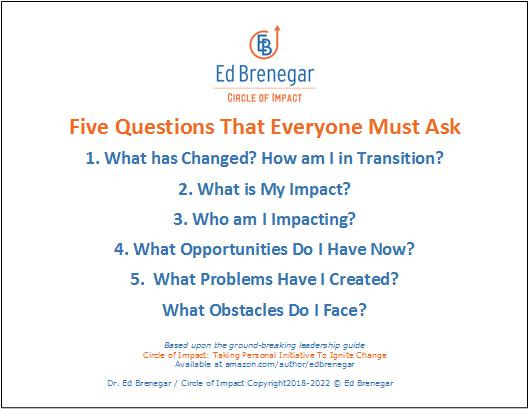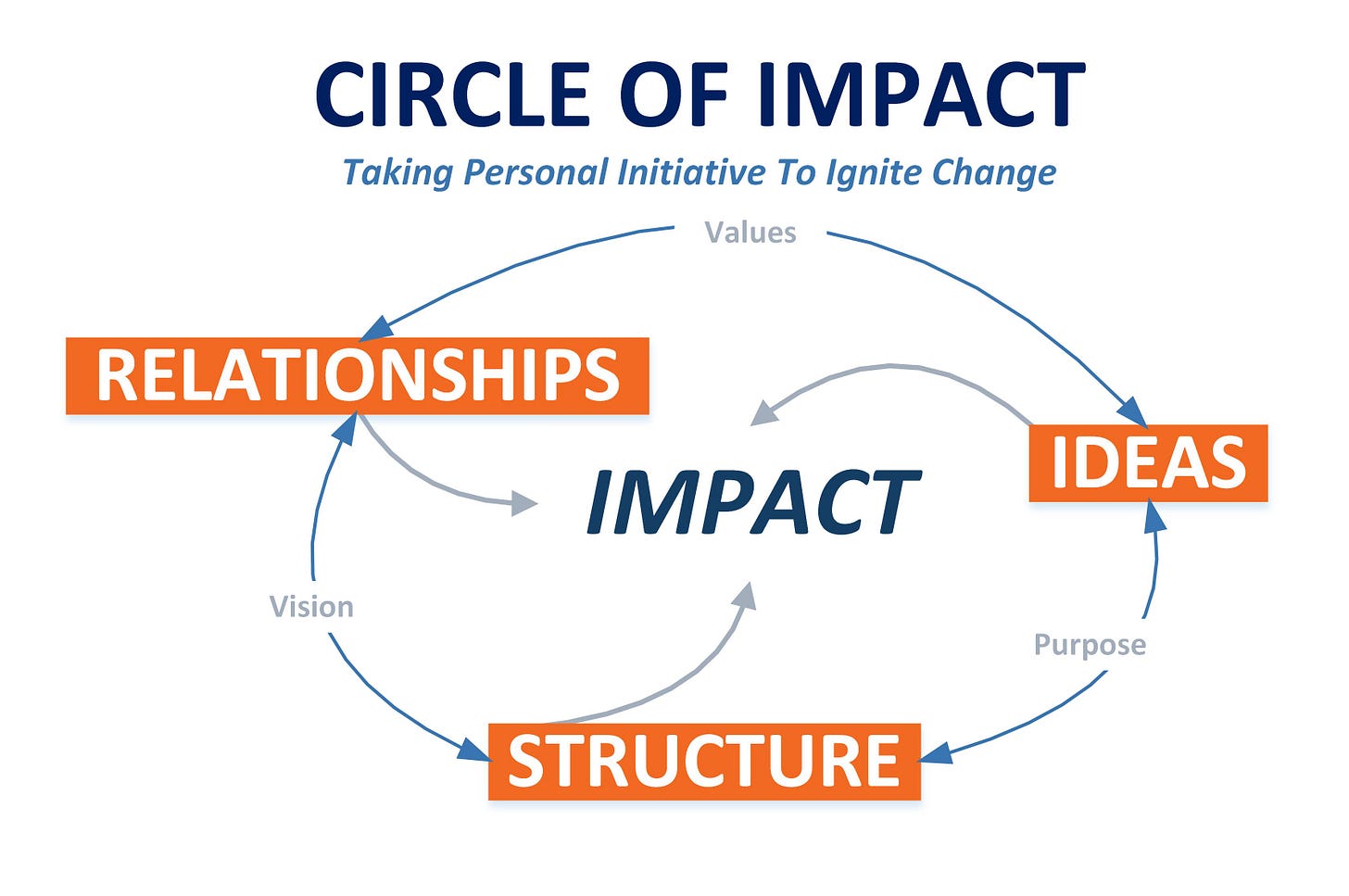The Mechanics of a Network of Relationships
Utilizing the Circle of Impact model of leadership your network of relationships will function well.
I am assuming that you have read my previous post about creating a network of relationships. Now, let’s look at making them function properly.
Who Owns the Network?
If you initiate the network it is your network. You are asking others to join your group. You are ultimately responsible for its management.
You need to be clear why you have created the network. Use the Five Questions That Everyone Must Ask to articulate the purpose for your network. You need to be able to say, “This is the Impact that I want to have. I need your help to achieve it.”
When you ask people to join, you are asking them to Participate and Contribute. You need to be able to describe clearly and specifically what you expect from them.
If there are three people, including yourself in the network, then you can ask them how and what frequency they would like to meet.
I’ve just joined a network and we meet quarterly. We have a focus for our meetings. It isn’t a local change group. It is rather a global understanding one. There are twenty to thirty in our group. So, it will take a bit more time for the group to meld together.
Last year when I began the Global Impact Network, I was clear that these networks were not mine. They were the person who wanted to start one. I simply facilitate their formation and development.
Ownership does not mean that you dictate to everyone. Instead, you are setting the parameters for the group.
A Network is a Team
A Network of Relationships exists somewhere between a casual friendship and a business partnership. It is closer to a team than anything else. You are playing together on the field of impact.
A team has a purpose, a set of goals, a context within which they play their game, and different roles to play. There is also a limit to the game. There needs to be a limit to the time the network exists. Achieve the goal. Close the network. Reopen a new network if you want. Or join someone else’s network. In the end, the network is a vehicle for relationship building. Relationships can last, but networks don’t.
Fleshing Out the Five Questions That Every One Must Ask
If you have used the Five Questions that Everyone Must Ask to create your network, then you will know the following information based on each question. This is a good way to vet people if they are going to be actively involved in the network.
Having some entrance requirements, like answering these questions, will demonstrate the seriousness of the person. I prefer to ask these in conversation. This isn’t to prove something but rather to get to know why they might want to join.
Question One: What has changed? How am I in Transition?
Each person needs to be able to describe why they want to invest themselves in the network. Ask the question this way.
What was that moment in the past that you first became aware of this issue, problem, or question?
How has your awareness of it developed since that first moment?
If you could change that situation, what would you do, and how long do you think it should take.
Remember the fifth principle of the Circle of Impact:
Question Two: What is My Impact?
Or if it is a situation, ask …
What is the Impact of the situation?
Where the first question identifies a change or changes that happened, the second question qualifies that change? You want to find out how this change or set of changes matters.
Or if it is about the person, ask …
What is the impact that you are having in this situation?
How can our network help your impact to grow?
Question Three: Who Did I Impact?
Or you can ask …
What people or groups were impacted?
Or, ask …
Who do you want to impact?
The purpose here is to identify the widest possible range of people who could have been impacted or need to be impacted.
This list applies to other possible members of your network. Especially if they have experience resolving the problem if there is one.
Question Four: What Opportunities do I now have?
We are assuming that your network is organizing to create change. This is not organized to be a social hour. If it is for a social purpose, you need a clear purpose for why a group meets together. Your network certainly could form to address a past traumatic situation. If so, then be clear about what the outcomes are that you want everyone to assist in creating. I am in a group that meets for two hours weekly. We do not have an agenda except to engage in deep conversation.
The opportunity I now have is an invitation to impact.
Question Five: What Problems have I created? What Obstacles do I face?
By identifying the impact that you want to have and acknowledging that there are opportunities to achieve them, we are more likely to invest ourselves in resolving the problems that are before us.
Aligning a Network for Impact
The Circle of Impact model of leadership provides a framework for organizing your group. The way we do this is to align the three dimensions of leadership - Ideas, Relationships, and Structure.
The image is a circle because you can enter at any point and create alignment by touching all three dimensions of leadership.
The linear understanding of the circle is this sequence.
Identify the problem or situation that brings you into the process.
What are the values that guide your life and work, that you are bringing into this project?
What is your purpose for impact? You need to identify both your purpose and your desired impact. Purpose is personal or strategic. Impact is the outcome.
Your vision is derived from the Relationships dimension.
In creating a network or a team, what are the shared values that are essential for inclusion in the team? These shared values are the foundation for relationships of respect, trust, and mutual accountability.
Out of your relationships, what is your shared vision for impact?
What kind of structure do you need to fulfill the shared purpose and vision for impact? Structure does not drive the process. Shared purpose through relationships of respect, trust, and mutual accountability drive the process.
Let’s dig deeper into the three dimensions of leadership.
Ideas
Ask yourself these questions.
What are the values that inform my purpose and the impact that I want to achieve?
What is my purpose for this network?
What is the desired impact of the network?
In other words, what is the change that makes a difference that matters that I want to create through the structure of a network of relationships?
Relationships
In the Circle of Impact model, the quality measure of our relationships are
Respect
Trust
Mutual Accountability
These are not sentimental or idealistic terms.
Ask yourself and the members, “What is the impact of our values and our relationships practiced through respect, trust, and mutual accountability?”
Structure
Structure is the vehicle for your ideas and relationships to fulfill their potential. Its quality measure is impact. In other words, if you aren’t creating impact, either you must change your approach or shut down the network.
Structure of a network should include:
When are we meeting?
Where are we meeting?
What is the agenda of the meeting? Use the Five Questions to organize the agenda.
How often do we want to meet and for how long?
Who is responsible for the meeting? Does this role rotate?
What resources do we need for our projects?
As you can see, the range of questions goes on and on.
Making a Network Work
I believe networks should start small with low expectations. Take time to get to know one another. Let the group decide how they want to function. As the network leader, you are the facilitator of the process and delegator of tasks.
Let me reiterate from the earlier post how to begin this process.
Step One: Know Yourself
Be able to state your values, your purpose, and the impact that you want to create.
Remember that impact is “a change that makes a difference that matters.”
Step Two: Identify Your Network
Look for 30-50 people to talk about the purpose of your network. Initial goal 3-5 people.
Start Small. Act Locally.
Define the impact that you want the network to create. This is your decision and those in the network. No one else sets the focus.
Do not incorporate as a business. Treat the network as a purpose for a specific period of time. One year? Eighteen months? Allows people the time to develop their commitment without feeling like they signed on to some life-long commitment.
After the initial group is set, add people by collective agreement.
Step Three: Creating a Sustainable Network
Regularly ask the Five Questions That Everyone Must Ask to guide development.
Identify what Participation and Contribution mean for each person.
Meet more regularly than you initially feel is necessary.
What does a meeting look like?
Plan according to the Five Questions That Everyone Must Ask.
Step Four: Write It Down
Keep a journal. Take notes. Write down every thought. You don’t know what is important until you need it.
A Word of Caution
I realize that I have given you a lot of material. It is important to understand the scale and scope of what is possible.
Don’t try to be perfect. There is no perfection. Perfection is boring. Imperfect is where the edge of impact is.
To begin, engage one person in person in conversation. They will tell you whether your idea makes sense.
Then find a second person. Take notes.
Ask them who you need to know. Call them up.
If as you begin, you do not feel that you have a command of the topic that interests you, write down questions that you have. Ask those questions of the people you meet.
Listen. Take notes.
Take it slow. Have fun.
A Word of Encouragement
Believe this.
The Circle of Impact Challenge
Regardless of who you believe you are,
or what challenges you have experienced in life,
or what obstacles you face right now,
never stop believing that you can be a person of impact who can
make a difference that matters.
You are the measure of your life.
You are the measure of your network.
When in doubt, remember why you are taking initiative.
Your impact does matter.
Never give up.





